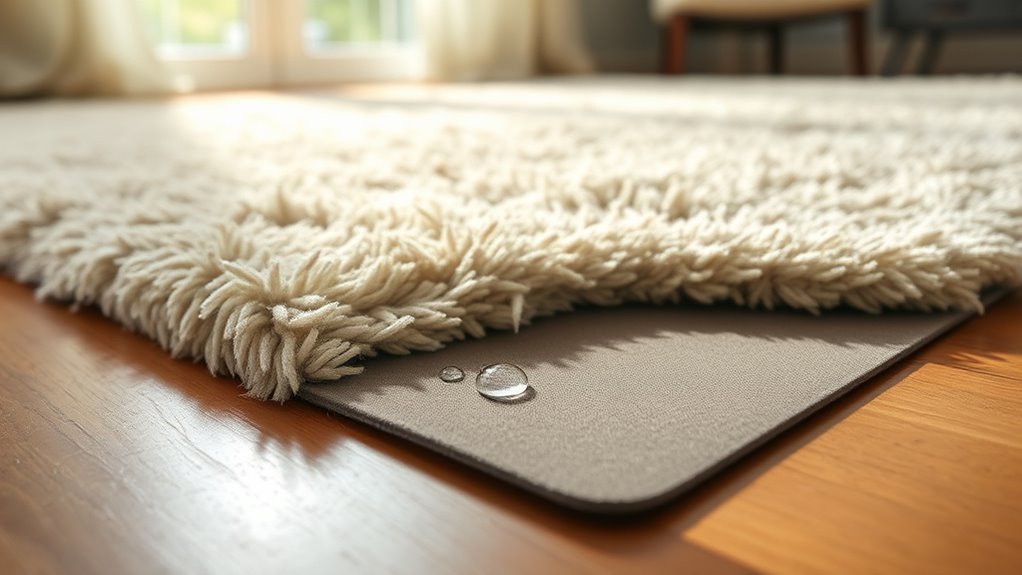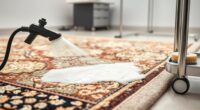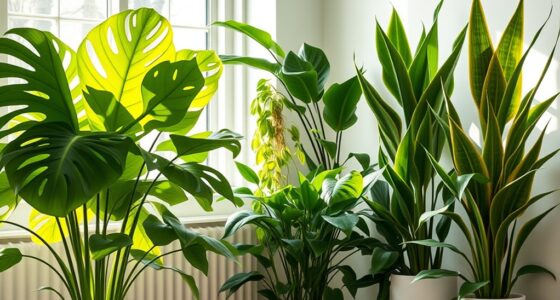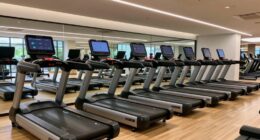Mold-resistant rug pads are effective at preventing mold growth when they’re properly designed, installed, and maintained. They use materials like synthetic fibers, waterproof layers, and antimicrobial coatings to inhibit spores and reduce moisture buildup. Regular inspection, cleaning, and good ventilation are key to maintaining their effectiveness over time. While they don’t guarantee mold-proof results, understanding how to care for them can substantially reduce your risk. If you want to learn more, there’s helpful information ahead.
Key Takeaways
- Mold-resistant rug pads incorporate moisture-repelling materials and antimicrobial coatings to inhibit mold growth effectively.
- Proper installation, regular cleaning, and ventilation are essential to maintain their mold-resistant properties over time.
- They reduce moisture retention and improve airflow, lowering the risk of mold compared to standard rug pads.
- While effective, mold-resistant pads are not entirely mold-proof and require ongoing maintenance.
- Environmental factors like humidity and moisture exposure can still impact their long-term performance.
How Do Mold-Resistant Rug Pads Prevent Growth?
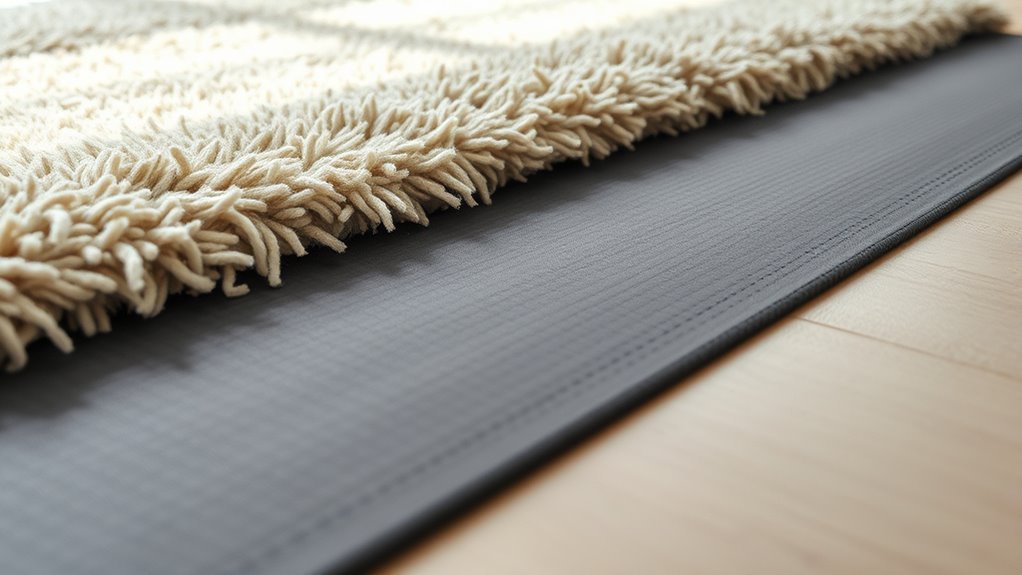
Mold-resistant rug pads prevent growth by incorporating materials and treatments that inhibit mold spores from thriving. The fiber types used in these pads are carefully chosen for their resistance to moisture retention and mold growth, such as synthetic fibers like polyester or polypropylene. These fibers naturally resist absorbing water, reducing the damp environment mold needs to flourish. Chemical treatments play a pivotal role by adding antimicrobial agents that actively inhibit mold and mildew development. These treatments can be integrated into the fibers during manufacturing or applied as a coating, creating a protective barrier. Additionally, selecting moisture-resistant fibers that reflect a sense of freshness and cleanliness can complement the use of mold-resistant rug pads. To further enhance protection, some pads incorporate antimicrobial coatings that continuously work to prevent mold formation. Incorporating proper ventilation practices in your space can also significantly reduce moisture levels, further preventing mold growth. By combining moisture-resistant fiber types with effective chemical treatments, mold-resistant rug pads effectively prevent mold growth, ensuring your rugs stay fresh and mold-free over time.
Materials Used in Mold-Resistant Rug Pads

To effectively prevent mold growth, the materials used in rug pads are carefully selected for their moisture-resistant properties. Waterproof materials, such as rubber or vinyl, form the core of many mold-resistant rug pads, preventing water from seeping in and creating a breeding ground for mold. Additionally, antimicrobial coatings are applied to the surface or embedded within the pad, actively inhibiting mold spores and bacteria from developing. These coatings are typically made from chemicals that block microbial growth, ensuring the pad stays cleaner and mold-free over time. The combination of waterproof materials and antimicrobial coatings creates a barrier that not only resists moisture but also actively fights mold growth, making these rug pads a reliable choice for damp or humid environments. Some designs also incorporate mold-resistant features that further enhance their effectiveness in preventing mold development. These features often include breathable materials that improve airflow and reduce moisture buildup around the rug, which is essential for moisture control, and ventilation systems that promote proper airflow and drying, thereby maintaining a healthier environment.
Effectiveness of Mold-Resistant Features Over Time
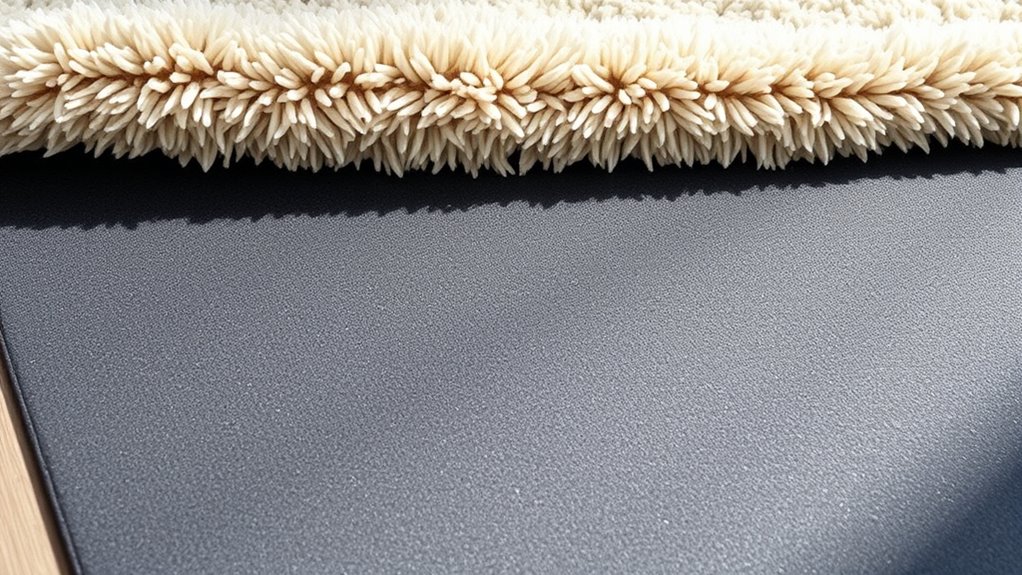
You might wonder how well mold-resistant rug pads hold up over time. As conditions change, their durability and long-term effectiveness can vary. It’s important to contemplate whether these features continue to protect your rug and indoor air quality year after year. Additionally, understanding the longevity of mold-resistant features can help you make informed decisions about maintenance and replacement. Studies indicate that automation technologies can enable scalability and flexibility in managing such features, ensuring ongoing protection. Regular inspections and proper cleaning can also extend the efficacy of mold-resistant properties, maintaining their protective qualities over the lifespan of the rug pad.
Durability of Mold Resistance
Over time, the effectiveness of mold-resistant rug pads can diminish due to exposure to moisture, foot traffic, and cleaning agents. This makes understanding the durability of mold resistance essential. Durability testing helps determine how well these features hold up under regular use, revealing whether mold resistance remains intact after months or years. Factors like wear, cleaning, and environmental conditions can weaken protective coatings or materials, reducing their ability to prevent mold growth. You should look for rug pads that have undergone rigorous durability testing, ensuring their mold-resistant properties won’t quickly fade. Additionally, proper maintenance practices can prolong the lifespan of mold-resistant features, helping ensure long-term protection. While initial mold resistance might be promising, knowing how long it lasts helps you make a smarter, long-term investment in your home’s health and indoor air quality, which is closely linked to mold prevention. The integration of sound healing science and advances in material durability can also inform better design choices for mold-resistant products.
Long-Term Effectiveness
While mold-resistant rug pads are designed to maintain their protective features over time, their long-term effectiveness depends on several factors. Proper maintenance is vital; regularly cleaning your rug pad helps preserve its moisture barrier, preventing mold growth. Over time, exposure to humidity or spills can weaken the mold-resistant coating, reducing odor control and moisture resistance. Choosing a high-quality, durable rug pad enhances longevity, guaranteeing mold resistance remains effective. Additionally, good ventilation in your space reduces moisture buildup, supporting the pad’s protective features. Remember, even the best mold-resistant rug pads need proper care to stay effective. By maintaining cleanliness and controlling humidity, you help make sure your rug pad continues to block moisture and odors, safeguarding your home against mold over the years. AI-driven solutions are increasingly being explored to develop more durable and self-maintaining mold-resistant materials.
Proper Installation and Maintenance Tips

To keep your mold-resistant rug pad effective, you need to guarantee it’s properly secured and stays in place. Regular cleaning helps prevent moisture buildup that can lead to mold growth. By following these simple steps, you’ll extend the life of your rug pad and maintain a healthy environment. Additionally, choosing an organic material for your rug pad can further reduce the risk of mold and improve sustainability. Proper installation techniques can also prevent slipping and ensure the pad functions as intended. Understanding moisture buildup and how to properly care for your home environment can also contribute to overall well-being.
Secure Rug Placement
Proper installation and regular maintenance are essential to keep your rug securely in place. When setting up an antique rug, ensure the rug pad is the right size and fits snugly beneath it. A well-chosen rug pad prevents slipping, reducing trip hazards and protecting your pet’s safety. Check the pad periodically for signs of wear or shifting, especially in high-traffic areas. Secure placement also involves smoothing out wrinkles and ensuring edges lay flat, which helps prevent curling that could cause falls. For added stability, consider double-sided tape or non-slip pads designed for rugs. Using a rug pad with sufficient horsepower can enhance grip and stability, especially on smooth flooring surfaces. Maintaining a secure rug placement safeguards your antique rug’s condition and creates a safer environment for everyone in your home, especially curious pets. Regularly cleaning and inspecting your rug pad can also prevent slippage and prolong its effectiveness. Additionally, selecting a high-quality non-slip material can further improve overall safety and durability. Properly caring for your rug pad and ensuring it’s made from durable non-slip materials can significantly extend its lifespan and effectiveness.
Regular Cleaning Practices
Regularly cleaning your rug is essential to maintain its appearance and durability. Consistent vacuuming removes dirt, dust, and allergens that can degrade the rug and impact air quality. Use a vacuum with a HEPA filter to trap tiny particles, which helps with allergy relief. Spot clean spills immediately to prevent mold growth, especially if you have a mold-resistant rug pad underneath. Deep cleaning, such as steam cleaning, should be done at least once a year to eliminate hidden mold and bacteria. Proper maintenance keeps your rug fresh, reduces airborne allergens, and improves indoor air quality. Additionally, make sure your rug is fully dry after cleaning to prevent mold development, which can compromise the effectiveness of mold-resistant rug pads over time.
Comparing Mold-Resistant Pads to Standard Options
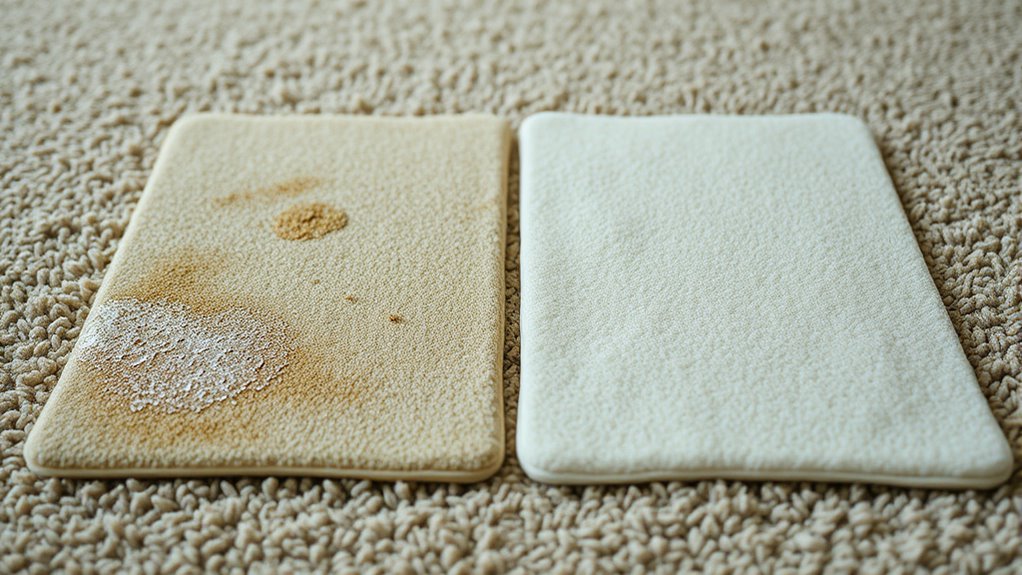
While mold-resistant rug pads often come at a higher price, they offer significant advantages over standard options. One key difference is fiber density; mold-resistant pads typically have a tighter fiber structure, which reduces air and moisture flow, making it harder for mold to develop. This density also enhances odor control, preventing musty smells caused by trapped moisture. Standard pads may feel softer or cheaper, but their looser fibers can trap dust and moisture more easily, increasing mold risks. Mold-resistant pads are designed to resist mold growth, making them a smarter choice if you’re concerned about indoor air quality. Although the initial investment is higher, their durability and health benefits often outweigh the cost, providing a cleaner, safer environment for your home.
Common Misconceptions About Mold-Resistant Rug Pads
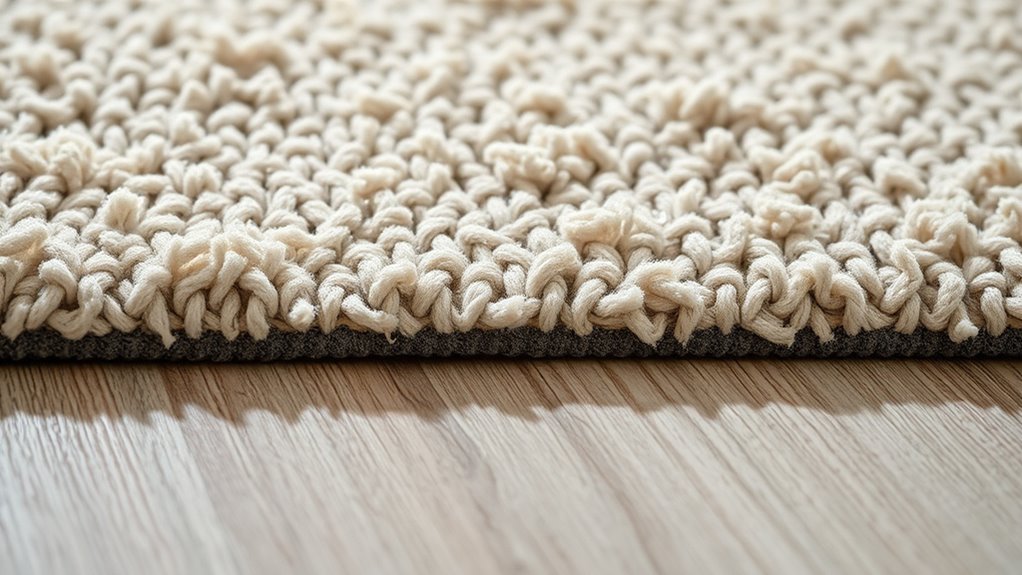
Many people assume that mold-resistant rug pads are completely impervious to mold, but this isn’t true. While antimicrobial coatings and moisture barriers help reduce mold growth, they don’t eliminate the risk entirely. Here are common misconceptions:
- Mold-resistant means mold-proof—it’s not; it just resists growth better.
- You don’t need to clean them regularly—routine cleaning prevents mold buildup.
- They last forever—wear and tear can compromise protective layers.
- They work in all environments—high humidity can still cause issues despite moisture barriers.
Signs That Your Rug Pad Is Failing

Over time, signs of a failing rug pad become noticeable through changes in your flooring or rug appearance. Look for mold growth indicators like discoloration, musty odors, or visible mold patches. These signs suggest your rug pad may be trapping moisture, reducing its lifespan. Regularly inspect the following:
| Issue | Cause | Action |
|---|---|---|
| Discoloration or stains | Moisture buildup, mold growth indicators | Replace the rug pad promptly |
| Smelly odors | Bacteria or mold development | Increase ventilation, consider replacement |
| Uneven rug positioning | Deterioration of the rug pad’s grip | Check for wear or damage, replace if needed |
Additional Strategies for Mold Prevention in the Home

To keep mold at bay, it’s important to adopt additional strategies beyond inspecting your rug pad. Focus on improving air circulation and humidity control throughout your home. Here are four key steps:
- Use exhaust fans in bathrooms and kitchens to reduce moisture buildup.
- Open windows regularly to increase airflow and dry out damp areas.
- Maintain humidity levels below 60% with dehumidifiers or air conditioners.
- Keep furniture and rugs elevated from the floor to promote better air circulation underneath.
Frequently Asked Questions
Are Mold-Resistant Rug Pads Safe for All Types of Flooring?
You might wonder if mold-resistant rug pads are safe for all flooring types. Generally, they’re designed with material safety in mind, making them suitable for various surfaces like hardwood, laminate, and tile. However, it’s wise to check the product’s environmental impact and guarantee it’s non-toxic. Always follow manufacturer guidelines to avoid potential damage or safety issues, and prioritize rug pads that are eco-friendly and compatible with your specific flooring.
Can Mold-Resistant Rug Pads Be Used Outdoors?
You can use mold-resistant rug pads outdoors, but keep in mind their outdoor durability varies. Look for pads specifically designed for outdoor use, as they withstand weather elements better. While they help prevent mold, consider their environmental impact—some may contain chemicals that aren’t eco-friendly. Regularly check and clean the pad to prolong its lifespan and maintain a healthy outdoor environment.
Do Mold-Resistant Rug Pads Emit Any Harmful Chemicals?
Did you know that many rug pads emit VOCs, which can affect chemical safety? When considering mold-resistant rug pads, it’s important to check for low VOC emissions, as some products contain chemicals that might off-gas harmful fumes. While these pads are designed to resist mold, their chemical safety varies; always opt for those labeled low or no VOC to guarantee healthier indoor air quality and reduce potential health risks.
How Often Should I Replace My Mold-Resistant Rug Pad?
You should replace your mold-resistant rug pad when you notice signs of mold, such as a musty smell or discoloration. Generally, it’s good to check the replacement frequency every 1-2 years, but this depends on humidity levels and usage. Regular inspections help guarantee your pad stays effective and safe. If you see any mold growth or persistent odors, replace it immediately to prevent health issues.
Are Mold-Resistant Rug Pads More Expensive Than Standard Ones?
Ever wondered if mold-resistant rug pads cost more than standard ones? The answer is yes, they often come with a higher price tag due to special materials and added technology. But don’t just focus on the cost comparison—think about durability factors. Mold-resistant pads tend to last longer and prevent mold growth better, making them a smart investment if you’re concerned about moisture and cleanliness.
Conclusion
By choosing a mold-resistant rug pad, you’re creating a safe haven under your feet, shielding your home from hidden moisture and mold. Imagine walking barefoot on a clean, dry surface, free from the worry of unseen spores lurking beneath. With proper care and installation, these pads become your silent protectors, keeping your space fresh and healthy. Embrace this simple step to transform your home into a cozy, mold-free sanctuary you can truly trust.
